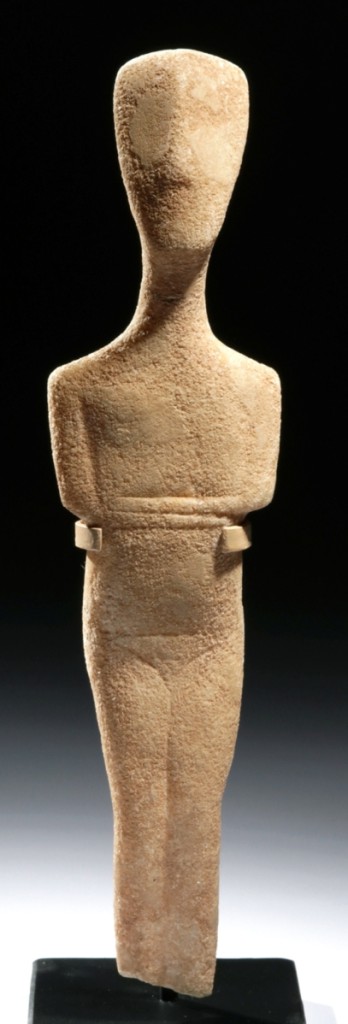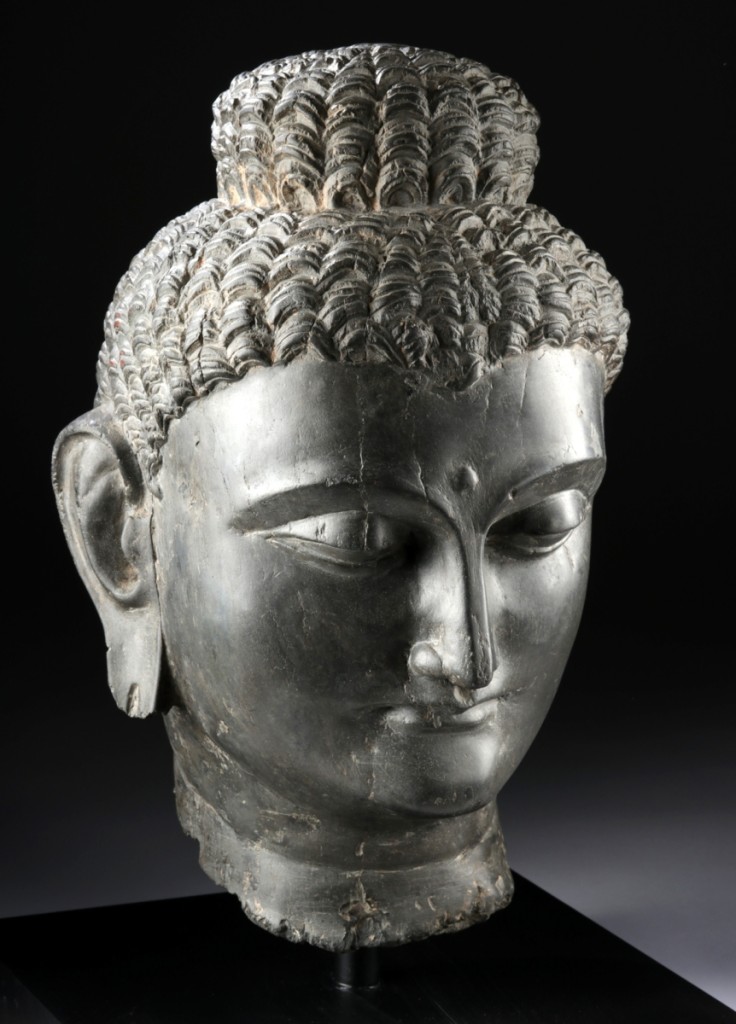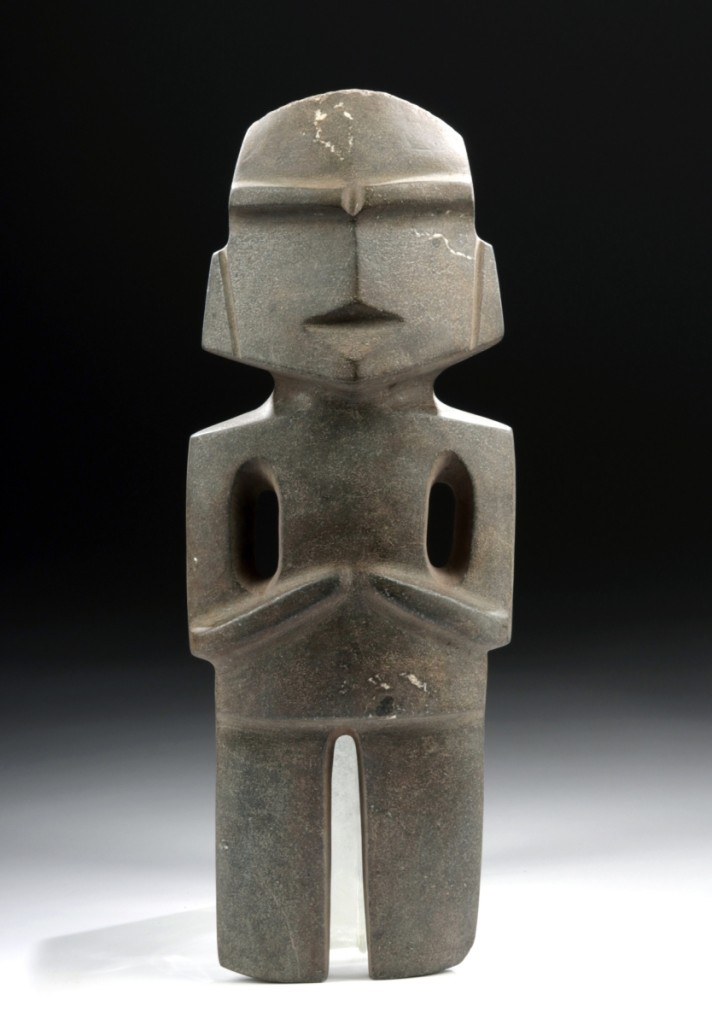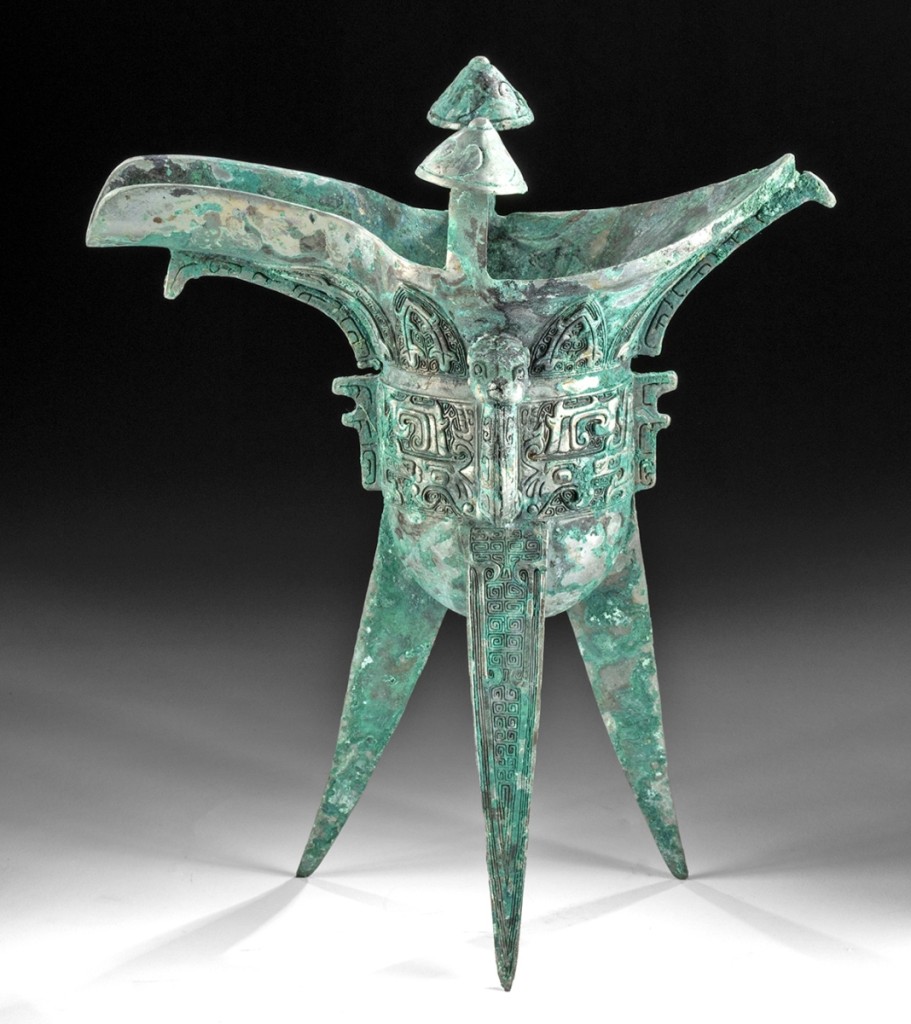
A Cycladic marble circa 2500 BCE finely carved reclining female figure, Spedos type, 9¾ inches high, sold for $301,250. Having crossed arms is typical of the sculpture of the Cyclades in the mid-2000s BCE, its name is derived from an early Cycladic cemetery on the island of Naxos.
Review by Anne Kugielsky, Photos Courtesy Artemis Gallery
LOUISVILLE, COLO. – In a field where authenticity and provenance are critically important, Artemis Gallery specializes in the sale of antiquities, ancient and ethnographic art.
Teresa Dodge, executive director, and co-owner with Bob Dodge, Elaine Jamieson and Phil Keck, said, “Our niche is very specific, which is both good and bad. Good because we are known for our expertise in selling authentic, legally acquired objects from ancient and ethnographic cultures (and have been since 1993), and this continues to bring us new collections to sell and new bidders to buy.
“Bad, because the potential buyer pool is shrinking faster than the collections coming to us. The truth is that new collectors are younger and not all that interested in ‘old stuff,’ like the previous generation. They may want to acquire certain genres, but the ‘total collection’ concept is gone. Plus the average collector of ancient art is male, 60-plus years old, and as they are aging / dying off, their children typically want nothing to do with their collection. Good for us absolutely, but then finding the new collectors to sell to is the challenge.”
But Dodge went on to say that what is “very good” for Artemis is “that established, high-end dealers see how we’re moving merchandise and are joining in and having us sell their inventory for them. They still continue to sell via their retail store, but we deliver what they don’t have access to – the hundreds of thousands of potential bidders from all over the world that our auctions provide.”
The Colorado company’s two-day auction, September 26 and October 3, was highlighted on day one by a Cycladic marble figure Spedos type that sold for $301,250. The circa 2500 BCE finely carved marble reclining female figure came with impeccable provenance: ex-private collection of Dr Best (collector of Cycladic art) and Dr Banting, well-known physicians in Canada who discovered insulin in the 1920s, acquired in 1972 from Sotheby’s London, “Egyptian, Western Asiatic, Greek, Etruscan and Roman Antiquities” 4 December 1972, lot 178. This auction featured property from the H.J.P. Bomford collection, including this piece.

A larger-than-lifesize, finely carved and polished grey schist head of Buddha from Central Asia, Pakistan and Afghanistan, carved during the Gandharan Empire, circa 200 CE, 15½ inches high, with hair styled into a large ushnisha, garnered $34,238.
The 9¾-inch-high sculpture with her arms crossed is typical of the sculpture of the Cyclades in the mid-2000s BCE known as the Spedos variety, this name derived from an early Cycladic cemetery on the island of Naxos.
Day two of the auction on October 3, featured pre-Columbian art from the ancient Americas, Native American, African / Tribal, Oceanic, Spanish Colonial and fossils. The top lot of day two was a huge (more than 16½ inches high) Guerrero Mezcala greenstone type M-14 figure which realized $31,125. The circa 300 to 100 BCE abstract standing anthropomorphic figure is hand-carved from dark green stone with beige and grey inclusions.
The two-day Exceptional Auction outperformed all other auctions in Artemis’ history by more than $100,000, Dodge confirmed, “so it definitely could be called a success. Instead of cramming everything into one auction, one day, breaking things up and spacing the sales apart by a week had a very positive affect on bidder registration and ultimate bidding. After-auction sales have contributed an additional 15 percent to the total sales thus far.”
Artemis Gallery conducts all its auctions online only and has done so since 2010. “Our phone bidders make up almost 20 percent of our bidding now, coming from all over the world.”
Teresa Dodge told Antiques and The Arts Weekly that it is Bob Dodge, founder and executive director of Artemis Gallery who is the acknowledged expert in the field of ancient art. She said, “Bob can tell what’s authentic or fake in a blink of an eye. He is the true expert of all things ancient, and he is the sole reason why our reputation for what we sell is among the best in our industry. He started Artemis Gallery part-time almost 30 years ago because of his love of the art.”
Bob also appears in the History Channel’s hit show, Pawn Stars, as their expert in ancient art. He has appeared in more than 13 episodes, with more than ten episodes in the works.

Topping day two was a large (16½-inch) Guerrero Mezcala greenstone type M-14 figure, which realized $31,125. The circa 300 to 100 BCE abstract standing anthropomorphic figure is hand carved from dark green stone with beige and grey inclusions.
Other highlights of day one included a larger-than-lifesize, 15½-inch, Gandharan finely carved and polished grey schist head of Buddha $34,238, circa 200 CE, which projected peace and harmony.
A circa 1045 to 771 BCE, handsome and ornately decorated jue, a ritual wine vessel cast from bronze, brought $31,125. With a patina of brilliant turquoise and some areas of pale silver color due to the relatively high percentage of lead in the bronze alloy, the Chinese Shang dynasty jue, 10¾ inches high, closely resembles one in the Metropolitan Museum of Art that sold at Christie’s for $32,500.
A large Roman stone mosaic of a regal couple with initials under the portraits sold at $31,250. Circa Third to Fourth Century CE, the sizeable mosaic comprised of thousands of square stone tesserae, showed a symbol between the heads that closely resembles a heart, making this both ancient and romantic.
Another portrait, this a rare mummy-portrait on linen, $19,920 Egypt in the Roman era, circa Second to Third Century CE, is similar stylistically and iconographically to Faiyum portraits. It depicts a beautiful, young, wealthy female wearing a refined long sleeve dress of breathtakingly vivid pastel pink hues with light and dark blue trim, and elaborately adorned with a double-strand necklace and a gold ring placed upon her right ring finger.
Another Egyptian piece, a painted wood and gesso sarcophagus panel sold after the auction closed at $23,655. A Roman Republic period marble head of an elderly, stern-looking man also sold for the same amount.
Dodge said, “We continue to expand into complementary categories so we can offer our customer base even more to be tempted by – Tribal / Oceanic, Native American, Spanish Colonial, Fossils and Fine Art.” Day two of the auction contained objects from these complementary categories.

With a patina of brilliant turquoise and some areas of pale silver color due to the relatively high percentage of lead in the bronze alloy, a circa 1045 to 771 BCE, Chinese Shang dynasty jue, a ritual wine vessel cast from bronze, brought $31,125.
A Panamanian gold double bird pendant, 166 grams, 5 by 4¾ inches, flew to $18,675. The pre-Columbian pendant, Veraguas, circa First to Fifth Century CE, had not one, but two conjoined birds, of between 14K to 18K gold.
An exceedingly rare blackware pottery vessel in the form of a dancing dog, pre-Columbian, West Mexico, Colima, circa 100 BCE to 250 CE, brought $13,965. The dog stands more than 9¾ inches atop attenuated hind legs with a rotund abdomen, a pair of raised fore legs, a stocky neck and a thick tail with a curled tip on the verso for balance.
Rounding out the top lots on October 3 were items from different categories: a Moroccan, late Cretaceous fossilized Mosasaur skull sold at $13,965. The 39-inch skull, circa 101 to 66 million years old, came from a private, Ohio, collection; a 1900s Mexican Colt revolver that once belonged to General Pasqual Orozco, realized $11,205 and a Native American, Southwestern United States, Mimbres Valley, N.M., prehistoric bowl with fish decoration, circa 950 to 1150 CE, that sold at $11,199.
Theresa Dodge concluded that it is “Bob’s eye, his knowledge, his thirst for being the best in the business, that is the ‘secret sauce,’ to our success.” She continued, “OK, well me too (I’m in charge of sales and marketing), our business partner and friend, Elaine Jamieson (finance director), and Phil Keck, our VP of Operations, and our wonderful staff 15 who love what we sell as much as we do.”
All prices include the buyer’s premium as reported by the auction gallery. For further information, 720-890-7700 or www.artemisgallery.com.























